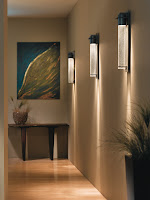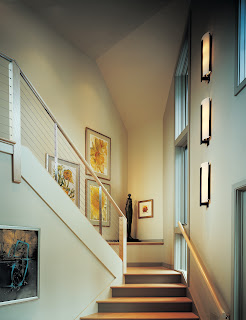 |
| Airis Sconce by Hubbardton Forge |
Wall sconces are a great way to add light and ambiance to a room. There are so many areas wall sconces can be used in a home, from the foyer, to hallways, living rooms, media rooms, bedrooms, bathrooms, and powder rooms. Adding light in strategic areas can make a room appear larger, or direct a flow of traffic throughout your home or office.
 |
| Hanna Wall Sconce and Chandeliers by Kichler |
 |
| Spyro Pendant and Wall Sconce by Kichler |
Wall sconces can serve as a functional element in a bedroom, but can also add a romantic ambiance. Sconces can be added on either side of a headboard, flanking the entry to the master bath, on either side of a window that overlooks some outdoor scenery, or to an area where one might put a dressing table. When placing sconces on either side of a head board, a swing arm light is a type of sconce that is typically used in bedrooms or offices. Swing arm wall lights add a decorative element to the "boring" reading light, and allow one person to read without disturbing the other. To avoid glare, install them so the shades are about 22 inches off of the mattress.
 |
| Bowed Swing Arm Sconce by Hubbardton Forge. Left and Right versions available. |
Bathrooms
are a popular area for sconces, and can make a Master Bath appear more formal
than other bathrooms in the house. For shaving and putting on make-up, the best
light should be even and shadow-free. To achieve this, light should come from
above and both sides. Wall sconces should be at least 28 inches apart
and centered 60 inches off of the floor. Of course, taller or shorter people
can adjust this guideline. Aside from adequate light at the vanities,
don’t overlook lighting the tub area and any architectural features. Sconces
used in conjunction with a recessed light over each sink will give adequate
light in a vanity area. If a recessed light is not an option, but you would
still like to use sconces, make sure the sconce is rated for at least 100 watts
or equivalent. Also, put lights that are compatible with a dimmer on a dimmer
switch for a spa-like affect when soaking in the tub. Your Half Bath, or Powder
Room is a room your guests will frequently use. Higher quality sconces, when
applicable, should be considered for this area. The Powder Room offers an
opportunity to get creative with your lighting. Since this area is not
generally used for grooming, the lighting can be very dramatic. Remember that
dark colors absorb light, so plan for more than you think you need and use a
dimmer.
Contact us for help
making your home or office a more beautiful space. The Home lighter Inc. Family owned and operated since 1969.







